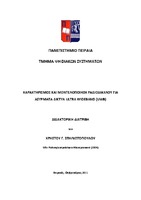Χαρακτηρισμός και μοντελοποίηση ραδιοδιαύλου για ασύρματα δίκτυα ultra wideband (UWB)

Doctoral Thesis
Συγγραφέας
Σπηλιωτόπουλος, Χρήστος Γ.
Ημερομηνία
2011-06-29Προβολή/
Θεματική επικεφαλίδα
Wireless communication systems ; Broadband communication systems ; Ultra-wideband devices ; Radio -- Receivers and reception ; Signal processingΠερίληψη
Η παρούσα διδακτορική διατριβή πραγματεύεται τον πειραματικό χαρακτηρισμό ραδιοδιαύλου για ασύρματα τηλεπικοινωνιακά συστήματα υπέρ ευρέως φάσματος (UWB). Στα πλαίσια της διατριβής σχεδιάστηκε και πραγματοποιήθηκε καμπάνια λήψης μετρήσεων για σήματα Ultra Wideband στον εντός στρατιωτικού αεροσκάφους μεταφοράς τύπου Hercules C-130 χώρο. To περιβάλλον του αεροσκάφους εμπεριέχει πάρα πολλές μεταλλικές επιφάνειες και αυτό έχει ως αποτέλεσμα την δημιουργία μεγάλου αριθμού πολυδιαδρομικών συνιστωσών. Τα πειραματικά δεδομένα χρησιμοποιήθηκαν αρχικά για τον χαρακτηρισμό του ραδιοδιαύλου UWB και στην συνέχεια για τον καθορισμό των κατάλληλων τεχνικών εκπομπής και λήψης. Υλοποιήθηκαν αλγόριθμοι υπολογισμού του εξαρτώμενου από την απόσταση συντελεστή των απωλειών διάδοσης για διάφορα συχνοτικά κέντρα και εύρη συχνοτήτων καθώς επίσης του εξαρτώμενου από την συχνότητα συντελεστή των απωλειών διάδοσης . Προτάθηκε μοντέλο υπολογισμού του συνολικού κέρδους διαδρομής το οποίο βασίσθηκε στην αρχή του διαχωρισμού μεταξύ των μεταβλητών του κέρδους που εξαρτάται από την απόσταση και του κέρδους που εξαρτάται από την συχνότητα. Το μοντέλο συγκρίθηκε με τα αποτελέσματα των μετρήσεων. Υλοποιήθηκαν αλγόριθμοι υπολογισμού των παραμέτρων της χρονικής διασποράς του καναλιού όπως η μέγιστη, η μέση υπερβάλλουσα καθυστέρηση και η r.m.s εξάπλωση καθυστέρησης καθώς επίσης του πλήθους των πολυδιαδρομικών συνιστωσών και του επί τοις εκατό ποσοστού της ενέργειας την οποία αυτές μεταφέρουν για διάφορες τιμές κατωφλίου στο προφίλ καθυστέρησης της ισχύος. Εξετάσθηκε η εξάρτηση των τιμών των παραμέτρων χρονικής διασποράς του ραδιοδιαύλου σε σχέση με την απόσταση μεταξύ πομπού και δέκτη και χρησιμοποιήθηκε εκθετική συνάρτηση για την μοντελοποίηση του πλήθους των πολυδιαδρομικών συνιστωσών και της r.m.s εξάπλωσης καθυστέρησης. Υπολογίσθηκε η χρονική συσχέτιση του πλάτους γειτονικών πολυδιαδρομικών συνιστωσών. Τέλος προτάθηκε ένα τροποποιημένο μοντέλο Saleh-Valenzuela για την περιγραφή του φαινομένου της δημιουργίας ομάδων πολυδιαδρομικών συνιστωσών στο οποίο χρησιμοποιείται διαφορετικός συντελεστής εκθετικής μείωσης των ακτίνων της πρώτης ομάδας σε σχέση με τις επόμενές της. Η κατανομή Weibull μοντελοποιεί τις διαλείψεις μικρής κλίμακας παρουσιάζοντας λογαριθμοκανονικές παραμέτρους σχήματος. Τέλος τα αποτελέσματα της εξομοίωσης του προτεινόμενου στατιστικού μοντέλου του καναλιού συγκρίνονται με τα μετρούμενα αποτελέσματα παρουσιάζοντας ικανοποιητική συμφωνία.


